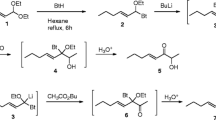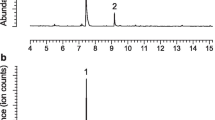Abstract
Males ofCarpophilus hemipterus (L.), the dried-fruit beetle, (Coleoptera: Nitidulidae) were found to emit nine all-E tetraene and one all-E triene hydrocarbons in addition to two pheromonally active tetraenes that had been reported previously. The previously known compounds are (2E,4E,6E,8E)-3,5,7-trimethyl-2,4,6,8-decatetraene(1) and (2E,4E,6E,8E)-3, 5,7-trimethyl-2,4,6,8-undecatetraene(2). The new tetraenes were all related to structure1 by having one additional carbon at either one or two of the following four locations: at carbon 1 of the chain, at carbon 10 of the chain, at the 5-alkyl branch, or at the 7-alkyl branch. (Structure 2 also fits within this pattern.) The triene inC. hemipterus is (2E,4E,6E)-5-ethyl-3-methyl-2, 4,6-nonatriene. Also identified from volatile collections from the beetles were the 2Z and 4Z isomers of1. All structures were proven by synthesis, with NMR and mass spectral data for the compounds provided. Two of the newly discovered compounds, (2E,4E,6E,8E)-7-ethyl-3,5-dimethyl-2,4,6,8-decatetraene and (2E,4E,6E,8E)-7-ethyl-3,5-dimethyl-2,4,6,8-undecatetraene, were quite active in the wind-tunnel bioassay, but others, such as (2E,4E,6E,8E)-5-ethyl-3,7-dimethyl-2,4,6,8-decatetraene and (2E,4E,6E,8E)-4,6,8-trimethyl-2,4,6,8-undecatetraene were not. Structureactivity relationships are explored among the natural compounds and additional, synthetic analogs, which were never detected from the beetles. Some of these analogs, such as (2E,4E,6E,8E)-3,5-dimethyl-7-propyl-2,4,6,8-undecatetraene, were quite active in the bioassay. The biosynthesis of the beetle-derived compounds is discussed. A single biosynthetic scheme that lacks complete enzyme specificity at four specific steps could account for the entire series of compounds found in the beetles and their relative proportions. The definition of “pheromone” is discussed in relation to these hydrocarbons.
Similar content being viewed by others
References
Bartelt, R.J., Dowd, P.F., Plattner, R.D., andWeisleder, D. 1990a. Aggregation pheromone of the driedfruit beetle,Carpophilus hemipterus: Wind-tunnel bioassay and identification of two novel tetraene hydrocarbons.J. Chem. Ecol. 16:1015–1039.
Bartelt, R.J., Dowd, P.F., Shorey, H.H., andWeisleder, D. 1990b. Aggregation pheromone ofCarpophilus freemani (Coleoptera: Nitidulidae): A blend of conjugated triene and tetraene hydrocarbons.Chemoecology 1:105–113.
Bartelt, R.J., Weisleder, D., andPlattner, R.D. 1990c. Synthesis of nitidulid beetle pheromones: Alkyl-branched tetraene hydrocarbons.J. Agric. Food Chem. 38:2192–2196.
Bartelt, R.J., Dowd, P.F., andPlattner, R.D. 1991. Aggregation pheromone ofCarpophilus lugubris: New pest management tools for the nitidulid beetles, pp. 27–40,in P.A. Hedin (ed.. Naturally Occurring Pest Bioregulators. ACS Symposium Series No. 449, American Chemical Society, Washington, D.C.
Boutagy, J., andThomas, R. 1974. Olefin synthesis with organic phosphonate carbanions.Chem. Rev., 74:87–99.
Dowd, P.F. 1987. A labor saving method for rearing the driedfruit beetle (Coleoptera: Nitidulidae) on pinto bean-based diet.J. Econ. Entomol. 80:1351–1353.
Dowd, P.F., andBartelt, R.J. 1991. Host-derived volatiles as attractants and pheromone synergists for driedfruit beetle,Carpophilus hemipterus.J. Chem. Ecol. 17:285–308.
Fienberg, S. 1977. The Analysis of Cross-Classified Categorical Data. MIT Press, Cambridge, Massachusetts. 151 pp.
Nelson, D.R. 1978. Long-chain methyl-branched hydrocarbons: Occurrence, biosynthesis and function.Adv. Insect Physiol. 13:1–33.
Poole, C.F., andSchuette, S.A. 1984. Contemporary Practice of Chromatography. Elsevier, Amsterdam. 708 pp.
Silverstein, R.M., Bassler, G.C., andMorrill, T.C. 1981. Spectrometric Identification of Organic Compounds. Wiley, New York. 442 pp.
Author information
Authors and Affiliations
Rights and permissions
About this article
Cite this article
Bartelt, R.J., Weisleder, D., Dowd, P.F. et al. Male-specific tetraene and triene hydrocarbons ofCarpophilus hemipterus: Structure and pheromonal activity. J Chem Ecol 18, 379–402 (1992). https://doi.org/10.1007/BF00994239
Received:
Accepted:
Issue Date:
DOI: https://doi.org/10.1007/BF00994239




